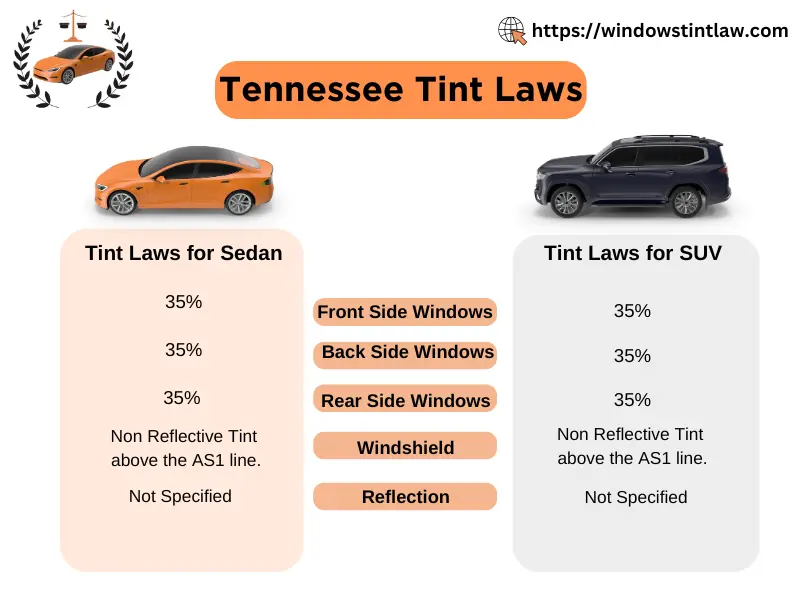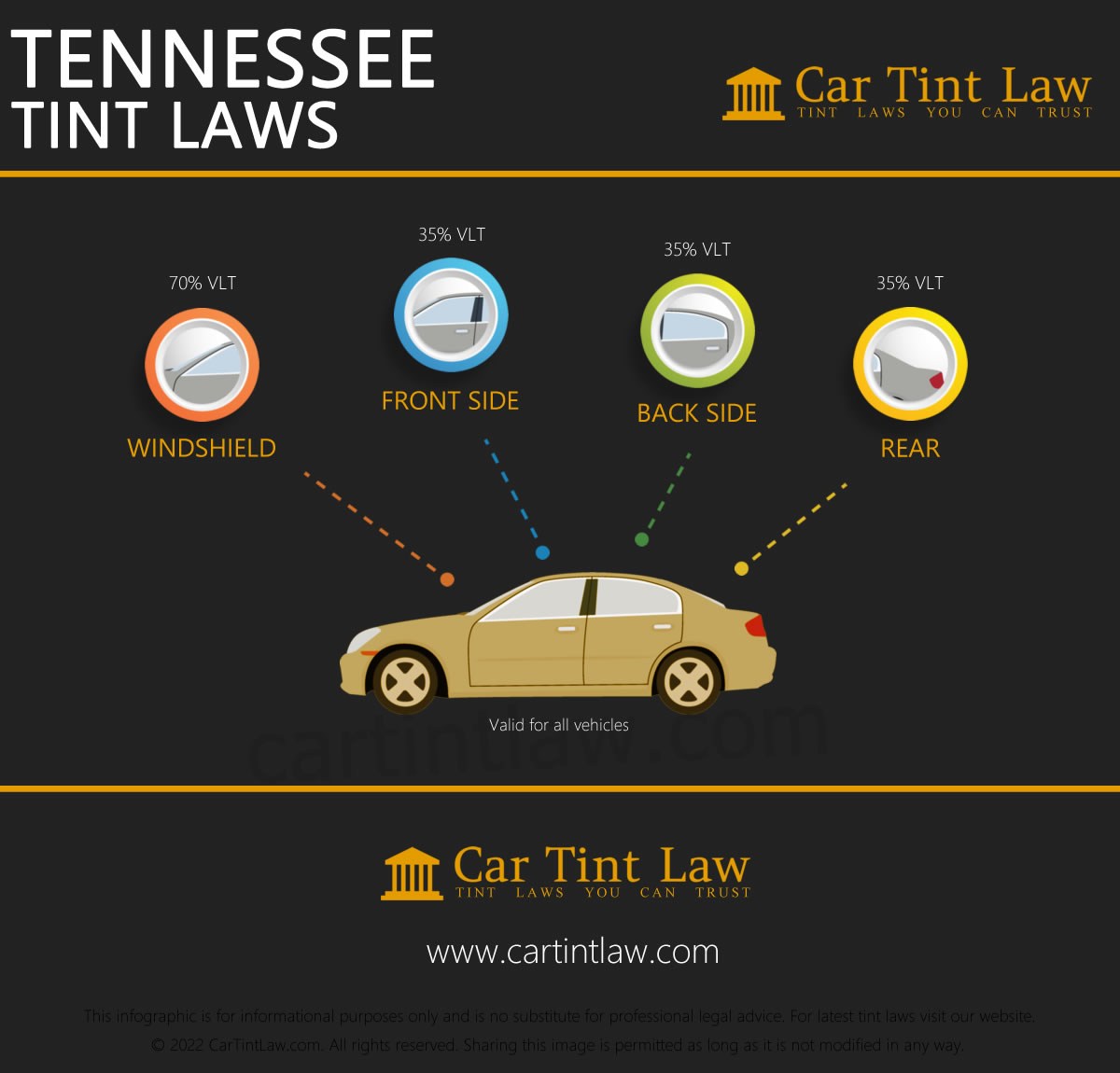You might be surprised at how much window tint can change your driving experience. It’s not just about style; it’s about comfort, privacy, and protection.
But before you decide to add a sleek tint to your vehicle’s windows, there’s something crucial you need to know: the Tennessee Tint Law. This is where many drivers get into trouble without realizing it, and you don’t want to be one of them.
Imagine cruising down the road, enjoying the privacy and reduced glare that tinted windows offer. Then, out of nowhere, you get stopped by law enforcement because your tint is too dark. Suddenly, that small detail you overlooked has become a big inconvenience. You deserve peace of mind when you’re behind the wheel, and knowing the ins and outs of Tennessee’s tint regulations is the key to achieving that. We’ll break down everything you need to know about the Tennessee Tint Law. You’ll discover how it affects your vehicle’s appearance and your driving experience. Plus, we’ll guide you through the legal limits and help ensure your vehicle stays compliant. Don’t let confusion about tint regulations disrupt your driving pleasure. Keep reading, because understanding these laws can save you time, money, and stress.
Overview Of Tennessee Tint Laws
Driving through the scenic roads of Tennessee, tinted windows can be a lifesaver against the glaring sun. However, it’s crucial to understand the state’s tint laws to avoid hefty fines and ensure your vehicle complies with legal standards. The Tennessee tint laws outline specific regulations that dictate how dark your car windows can be. Let’s break these down for clarity and keep you riding smoothly.
Legal Tint Percentages
In Tennessee, the law specifies how dark you can tint your vehicle windows based on Visible Light Transmission (VLT). This percentage refers to the amount of light that can pass through the window. For sedans, the front side windows must allow more than 35% of light in. The back and rear windows can be tinted to any darkness.
If you own an SUV or a van, you’re allowed to have the rear side windows and rear window tinted to any degree. However, the front windows must adhere to the same 35% VLT rule. Keeping these percentages in mind can save you from unnecessary legal troubles.
Applicable Vehicles
Are you wondering if your vehicle falls under these tint laws? Whether you’re cruising in a sleek sedan or navigating in a sturdy SUV, these rules apply. The laws cover all passenger vehicles, including trucks, vans, and SUVs.
Even motorcycles have their set of tint regulations. But, if you drive a commercial vehicle, different rules might apply, focusing more on safety and visibility. It’s always best to check the specifics based on your vehicle type to ensure compliance.
Have you ever driven with windows tinted too dark, only to be pulled over? Share your experience and how you navigated the situation. Ensuring your tint complies with Tennessee laws not only keeps you on the right side of the law but also enhances your driving experience.
What do you think about these tint restrictions? Do they make driving safer, or are they just another rule to follow? Reflect on how these laws impact your daily driving and consider the benefits of staying within legal limits.

Credit: windowstintlaw.com
Window Tint Restrictions
Tennessee’s tint law limits how dark car windows can be. Front side windows must allow over 35% light. Rear and back windows have more leniency, with lower light transmittance allowed. These restrictions aim to ensure safety and visibility on the roads.
Window tinting can add a sleek look to your car while providing privacy and protection from harmful UV rays. But before you tint your windows in Tennessee, you need to be aware of the state’s specific tint laws. These restrictions are designed to ensure safety for all road users.Front Window Limitations
Tennessee law requires that the front side windows allow more than 35% of light in. This means your tint cannot be too dark. Consider standing next to a car with tinted windows—can you see the driver? If not, the tint might be too dark. Some people have learned the hard way, facing fines because they didn’t check these regulations first. Keep your tint within legal limits to avoid unnecessary penalties.Back Window Allowances
The back side windows have more lenient rules, allowing you more freedom. In Tennessee, you can use any darkness of tint you prefer on these windows. This flexibility lets you enhance privacy for passengers in the back. However, remember that visibility is crucial when driving. A dark tint might look cool, but it can be a hazard if you can’t see clearly.Windshield Tint Rules
Tinting your windshield is a bit more restrictive. Tennessee law permits a non-reflective tint on the top five inches of the windshield. This is often called the “eyebrow” and helps reduce glare from the sun. But don’t go overboard. A full tinted windshield can impair vision, especially at night. Ever had trouble spotting a pedestrian or cyclist? That could be because of excessive windshield tinting. Understanding these rules can save you from a costly mistake. Always check the latest regulations or consult a professional before tinting your windows. Your safety—and your wallet—will thank you.Exemptions And Special Cases
Tennessee’s tint law sets specific rules for vehicle window tinting. These laws ensure safety and visibility on the road. Yet, not everyone must follow the same rules. Certain exemptions and special cases exist. These provide flexibility for those with valid reasons. Understanding these can help you comply better.
Medical Exemptions
Some people need darker tints for medical reasons. Conditions like lupus or photosensitivity may qualify. These individuals can apply for a medical exemption. A licensed physician must verify the condition. The exemption allows for darker window tints. This ensures comfort and safety for the individual.
Commercial Vehicle Exceptions
Commercial vehicles have different rules for tinting. These vehicles often carry goods or tools. Visibility is crucial for safe transport. The law permits certain levels of tinting. This helps in reducing glare and maintaining privacy. Yet, it still ensures road safety.

Credit: www.cartintlaw.com
Penalties For Non-compliance
Violating Tennessee’s tint law can lead to fines or legal action. Authorities may issue tickets for non-compliance. Repeated violations could increase penalties, affecting your driving record and insurance rates.
Understanding the penalties for non-compliance with Tennessee’s tint law is crucial if you want to avoid hefty fines and potential impacts on your insurance. Ignoring these regulations can lead to more than just a slap on the wrist. It could affect your finances and even your driving record. Let’s delve deeper into the consequences you might face if your vehicle’s tint doesn’t adhere to the state’s legal standards.Fines And Fees
Non-compliance with Tennessee’s tint law can result in fines that may surprise you. The initial penalty for violating the tint law starts at $50. But don’t let this seemingly small amount fool you. Repeat offenses can lead to increased fines, adding up quickly. Think about how these fines could affect your budget. Would you rather pay for a legal tint adjustment or face recurring fines? It’s not just about the money; frequent violations can also tarnish your driving record.Impact On Insurance
Your car insurance might also take a hit due to non-compliance. Imagine getting into an accident and finding out your claim is affected because your vehicle didn’t meet state tint regulations. Insurance companies might see tinted violations as a sign of risk-taking behavior. Could this lead to higher premiums or even claim denials? It’s a possibility worth considering. Ensuring your vehicle complies with tint laws is not just about avoiding fines; it’s about protecting your insurance rates. By understanding the potential penalties, you can make informed decisions about your vehicle’s tint. Are the risks worth it? Or is it wiser to comply and drive with peace of mind?Tips For Legal Tint Installation
Installing window tint on your vehicle is a fantastic way to enhance privacy, reduce glare, and protect interiors from UV rays. However, it’s essential to follow Tennessee’s tint law to avoid fines. Here are some tips for ensuring your tint installation is legal and effective.
Choosing The Right Tint
Research is the first step in choosing the right tint. Tennessee law allows specific visible light transmission (VLT) percentages. For sedans, the front side windows should allow more than 35% of light in. The back and rear windows can be darker. SUVs and vans have different rules. Ensure you know the legal VLT for your vehicle type. Consider the purpose of the tint. Do you want more privacy or just UV protection? Different tints offer various benefits. Choose one that aligns with your needs. Quality matters too. A high-quality tint lasts longer and performs better. Check reviews and ratings before purchasing.
Professional Vs Diy Installation
Professional installation guarantees quality. Experts understand Tennessee’s tint laws and ensure compliance. They have the right tools and experience for a flawless finish. Professional services often include warranties. This adds peace of mind in case of defects. DIY installation can save money. It requires patience and precision. If you choose this route, get a comprehensive kit. Follow instructions carefully to avoid bubbles or peeling. Watch tutorials to learn tips and tricks. Consider your skills honestly. If in doubt, consult a professional to avoid costly mistakes.

Credit: thetintlaws.com
Frequently Asked Questions
What Is The Darkest Legal Tint In Tn?
The darkest legal tint in Tennessee is 35% VLT for front side windows. Rear windows can have 35% VLT. The rear windshield can have any darkness. Ensure compliance with state regulations to avoid penalties.
In What State Is 20% Tint Legal?
20% tint legality varies by state. States like California and New York have strict tint laws. Texas allows 20% tint on rear windows. Check local regulations for specifics. Always ensure compliance with state tint laws to avoid penalties.
Can You See With 20% Tint?
Yes, you can see through 20% tint, but visibility is reduced. It’s darker, providing privacy and sun protection.
Which Is Darker, 30 Or 35 Tint?
30 tint is darker than 35 tint. Tint percentage represents light transmission, so lower numbers mean less light passes through. A 30% tint allows 30% of light to enter, making it darker compared to a 35% tint. Choose 30 tint for a more shaded appearance.
Conclusion
Understanding Tennessee Tint Law helps keep you safe and legal. Knowing tint limits prevents fines. It also ensures clear vision while driving. Always check local laws before tinting your windows. Rules can change, so stay informed. Choosing the right tint protects you from the sun’s glare.
It also provides privacy. Remember, safety and compliance are key. With this knowledge, you can make smart tint choices. Confidently drive with peace of mind. Stay legal, stay safe.
